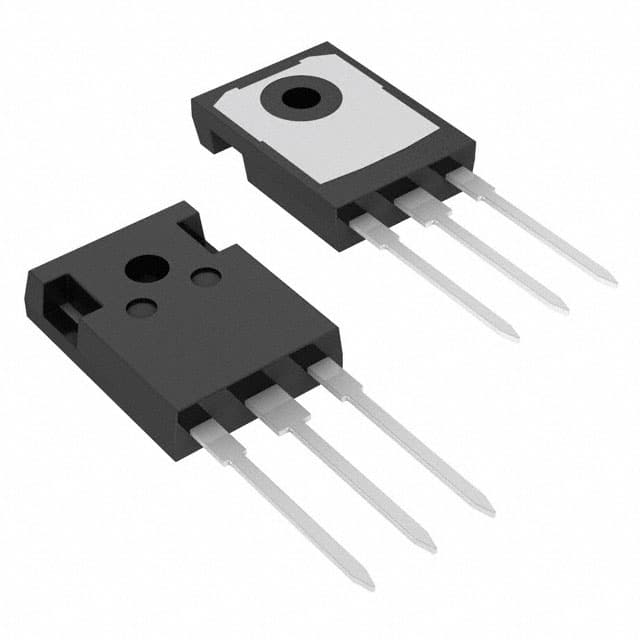Viz Specifikace pro podrobnosti o produktu.

FQH90N15: Product Overview and Analysis
Introduction
The FQH90N15 is a power MOSFET belonging to the category of electronic components. This device is widely used in various applications due to its unique characteristics and functional features. In this entry, we will provide an overview of the FQH90N15, including its basic information, specifications, pin configuration, functional features, advantages and disadvantages, working principles, application field plans, and alternative models.
Basic Information Overview
- Category: Electronic Components
- Use: Power MOSFET for electronic circuits
- Characteristics: High power handling capacity, low on-state resistance, fast switching speed
- Package: TO-3P
- Essence: Efficient power management
- Packaging/Quantity: Typically packaged individually
Specifications
- Model: FQH90N15
- Voltage Rating: 150V
- Current Rating: 90A
- Power Dissipation: 300W
- Operating Temperature: -55°C to 175°C
- Gate-Source Voltage (Max): ±20V
- On-State Resistance: 0.015Ω
Detailed Pin Configuration
The FQH90N15 typically has three pins: 1. Gate (G): Control terminal for turning the MOSFET on and off. 2. Drain (D): Connection point for the load in the circuit. 3. Source (S): Common reference point for the MOSFET.
Functional Features
- High Power Handling: Capable of managing high currents and voltages.
- Low On-State Resistance: Minimizes power loss and heat generation.
- Fast Switching Speed: Enables rapid control of the power flow in the circuit.
Advantages and Disadvantages
Advantages
- High power handling capacity
- Low on-state resistance
- Fast switching speed
Disadvantages
- Higher cost compared to standard MOSFETs
- Larger physical size due to higher power rating
Working Principles
The FQH90N15 operates based on the principles of field-effect transistors. When a voltage is applied to the gate terminal, it creates an electric field that controls the flow of current between the drain and source terminals. This mechanism allows for efficient power regulation and control in electronic circuits.
Detailed Application Field Plans
The FQH90N15 finds extensive use in various applications, including: - Switching Power Supplies: Utilized for efficient power conversion and regulation. - Motor Control: Enables precise control of motor speed and direction. - Inverters: Used for converting DC power to AC power in renewable energy systems.
Detailed and Complete Alternative Models
Some alternative models to the FQH90N15 include: - IRF1405: Similar power MOSFET with comparable specifications. - STP80NF70: Offers a different package and characteristics suitable for specific applications. - IXFN90N30: Provides alternative power handling and switching capabilities.
In conclusion, the FQH90N15 power MOSFET serves as a crucial component in electronic circuits requiring efficient power management and control. Its unique characteristics and functional features make it a versatile choice for various applications.
Word Count: 455
Seznam 10 běžných otázek a odpovědí souvisejících s aplikací FQH90N15 v technických řešeních
What is FQH90N15?
- FQH90N15 is a high-voltage, fast-switching N-channel MOSFET designed for various technical applications requiring efficient power management.
What are the key specifications of FQH90N15?
- The key specifications include a voltage rating of 1500V, a continuous drain current of 90A, and a low on-resistance for high efficiency.
In what technical solutions can FQH90N15 be used?
- FQH90N15 can be utilized in applications such as motor drives, power supplies, renewable energy systems, and electric vehicle charging stations.
How does FQH90N15 contribute to power management in motor drives?
- FQH90N15's high voltage rating and low on-resistance enable efficient power switching and control in motor drive systems, leading to improved performance and energy savings.
What advantages does FQH90N15 offer in power supply designs?
- FQH90N15's fast-switching capability and high current handling make it suitable for high-power, compact power supply designs with minimal heat dissipation.
Can FQH90N15 be integrated into renewable energy systems?
- Yes, FQH90N15 can be integrated into solar inverters, wind turbine converters, and other renewable energy systems to efficiently manage and convert power from renewable sources.
How does FQH90N15 support electric vehicle charging stations?
- FQH90N15's high voltage rating and current-handling capacity make it suitable for use in electric vehicle charging infrastructure, enabling rapid and efficient charging.
What thermal management considerations are important when using FQH90N15?
- Proper heat sinking and thermal design are crucial to ensure that FQH90N15 operates within its specified temperature limits for reliable performance and longevity.
Are there any application notes or reference designs available for FQH90N15?
- Yes, application notes and reference designs are available to assist engineers in implementing FQH90N15 in various technical solutions.
Where can I find detailed technical documentation for FQH90N15?
- Detailed technical documentation, including datasheets, application guides, and design resources, can be found on the manufacturer's website or through authorized distributors.

